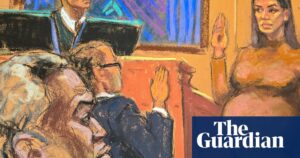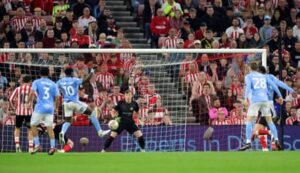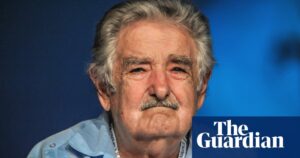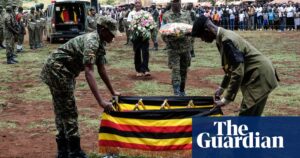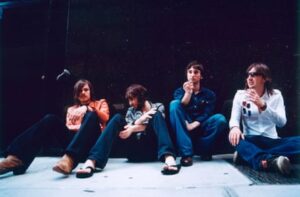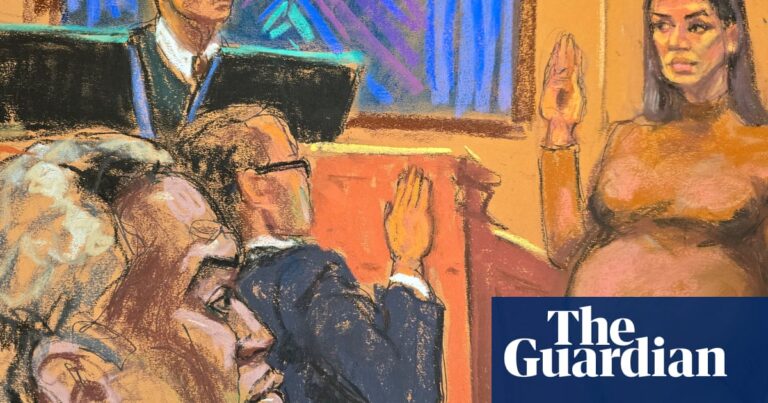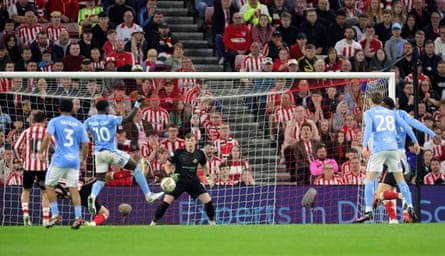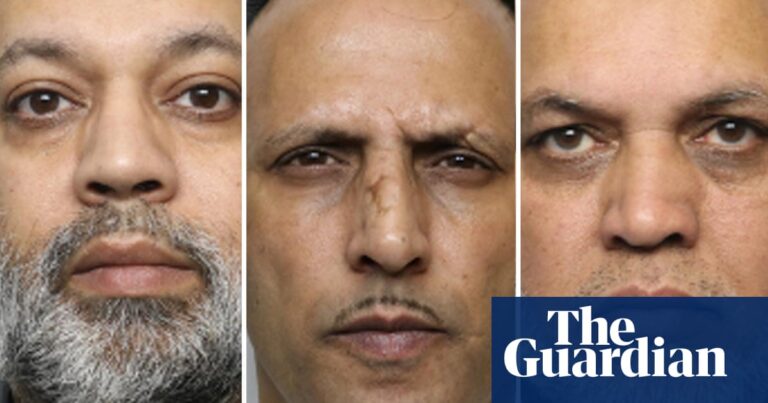At 11.45 on Thursday morning, six white-gloved pallbearers carried a coffin holding the body of the most divisive, beloved and reviled Peruvian politician of the last four decades. They passed the mourners, the cameras and the flag-topped lances of the Húsares de Junín cavalry regiment, and set it down in the hall of Lima’s brutalist culture ministry.
Behind the coffin, holding hands and dressed in black under a pale but warm spring sky, came its occupant’s eldest daughter and youngest son. A crowd of ministers, political allies and military top brass awaited them at the ministry.
And so began three days of national mourning to honour Alberto Fujimori, the political upstart who served as president of Peru from 1990 to 2000 and who, nine years later, was ordered to serve a 25-year sentence for authorising kidnappings and murders during his government’s “war against terrorism”.
On Saturday, after a state funeral at the ministry, supporters gathered as he was buried at the Campo Fe de Huachipa cemetery in the city.
The fact that Fujimori, who died of cancer aged 86 on Wednesday, was afforded the kind of send-off not seen since the 2020 funeral of the Peruvian former UN secretary-general Javier Pérez de Cuéllar may have infuriated many in the South American country, but it came as little surprise.
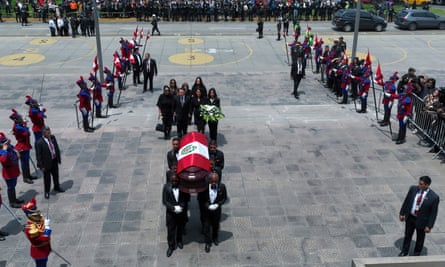
After all, the life and legacy of Fujimori – who was pardoned and released from prison just 10 months ago – is perhaps the most bitter and disputed topic in contemporary Peru.
To many, he will always be the cynical autocrat whose corruption, hunger for power and disdain for human rights poisoned the nation. To others, he will forever remain the political outsider who came from nowhere but somehow managed to defeat the twin scourges of terrorism and hyperinflation.
Those in the latter camp were evident on the streets outside the culture ministry on Thursday, where they queued, cheered and cried as they reminisced about the man affectionately known as “El Chino”, while floral wreaths sent by the country’s business elite piled up.
“He’s getting the honours he deserves because he was the best president in the history of Peru,” said Milagros Parra, 54, who had come with companions from the San Juan de Lurigancho neighbourhood on the outskirts of Lima.
“He inherited a country full of blood with massive hyperinflation. We have to thank him.”
Her friend Bonifacia Moreno, 79, was also grieving. “Our economy is thanks to him; our peace is thanks to him, she said. “Who will defend us now?”
Fujimori, the son of Japanese immigrants, was the all-but-unknown candidate who ran against the Peruvian novelist – and future Nobel prize-winner – Mario Vargas Llosa in the 1990 election, which was held after almost a decade of the Shining Path’s Maoist terrorism and years of economic upheaval.
With Vargas Llosa perceived as another candidate from the country’s white, Lima-centric elite, Fujimori, an agricultural engineer and mathematician schooled in France and the US, capitalised on his appeal to ordinary Peruvians by riding a tractor and pledging “honesty, technology, work”.
The pitch worked and Fujimori won. His drastic market reforms and deregulation of the Peruvian economy appealed to the business elite, while programmes to build schools, roads and bridges in poor, abandoned communities, won him votes and lifelong support.
As a result, said José Alejandro Godoy, the author of two books about Fujimori, “both wealthy and poor sectors continue to be the main bases of support for him and the political movement he founded”.
But, faced with economic and terrorist turmoil from the outset, Fujimori governed with an increasingly authoritarian hand in connivance with his spymaster, Vladimiro Montesinos, a corrupt lawyer and former soldier who offered him control of the judiciary and the armed forces.
Emboldened by broad public support, Fujimori embarked on the “war against terrorism” that eventually crushed the Shining Path insurgency and then the smaller Tupac Amaru Revolutionary Movement, which made headlines when it took hostages during a party at the Japanese ambassador’s residence in December 1996. The capture in 1992 of the Shining Path’s leader, Abimael Guzmán, proved a major coup – the much-feared terrorist mastermind was paraded in a cage in prison stripes – as did the operation that ended the siege at the Japanese ambassador’s residence in April 1997.

Desperate for an end to the bloodshed – the country’s truth and reconciliation commission would later establish that 69,280 people were killed between 1980 and 2000, 54% of them by the Shining Path – many Peruvians supported Fujimori’s “by any means necessary” tactics.
In the early 1990s, Fujimori holed up in the intelligence service headquarters from where he directed a dirty war using a death squad, the Grupo Colina, to carry out massacres for which he was eventually convicted and jailed for 25 years in 2009 in a landmark trial against a former head of state.
These crimes, which included the murder of an eight-year-old boy and a string of other human rights violations, turned a large sector of public opinion against Fujimori, as did increasing revelations of corruption.
But it took time. Even when he dissolved congress in 1992, allied himself with the military and co-opted national institutions to rewrite the constitution, allowing him to run for re-election, he still had broad support. With a chokehold on power, he gutted and corrupted public bodies and, via Montesinos, controlled a significant part of the press that trashed his opponents through tabloids known as the prensa chicha.
“He perfected the use of ‘fake news’ to control and subjugate the population,” said Jo-Marie Burt, professor of political science at George Mason University and a senior fellow at the Washington Office on Latin America.
Things finally began to fall apart towards the end of his second term when he began pushing for a third mandate using much of the apparatus of a co-opted state. Protests against his regime grew until they became daily in Lima and, after an election in 2000 that was beset with allegations of ballot-rigging – and the emergence of videos that showed Montesinos bribing lawmakers with stacks of cash – Peruvians tired of the Fujimori government and its graft.
Soon after, on an official trip to Asia, Fujimori fled to Japan, his parents’ homeland, and resigned the presidency by fax. But Peru’s congress rejected his resignation and, instead, stripped him of the presidency, arguing that he was “morally unfit” to be head of state.
With Fujimori in disgrace and, latterly, in prison, it was left to his daughter, Keiko, who had been his first lady since 1994 when her parents separated, to defend and perpetuate her father’s legacy. Today, Keiko, who has finished second in the past three presidential elections, remains the standard bearer for the political force known, after her father, as fujimorismo – a viciously divisive movement that has contorted Peruvian politics ever since he won power.
Fujimori may be dead, but experts say his shadow lingers – and will continue to do so for a while yet. Hundreds of thousands of women and men – many poor and Indigenous – are still seeking justice after being forcibly sterilised under his presidency.
For Godoy, the late president “degraded Peruvian politics to extremes rarely seen in national history” and can be considered the father of the “competitive authoritarianism” seen today in El Salvador under Nayib Bukele.
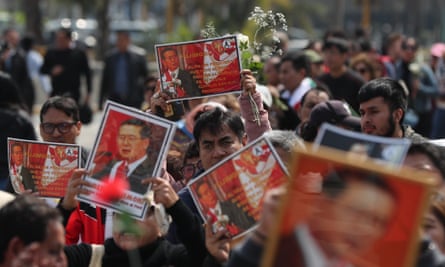
The author Michael Reid describes Fujimori as “a transformative president for better and for worse”.
Although many, unsurprisingly, associate the late president with human rights violations and the poisoning of democracy, Reid points out that “most poorer Peruvians look back on Fujimori as somebody who saved the country and somebody who improved their lives and the economy” during a time of crisis.
But, he added, Fujimori “introduced corruption as an instrument of rule and I think that was immensely damaging … Above all, his legacy, sadly, has been one of dividing Peruvians because he did rule as an autocrat from 1992 to 2000.”
As Peru digs in for the mourning period and the many memories it will stir up, some have noted that, in a quirk of fate, Fujimori died exactly three years to the day after his terrorist nemesis Guzmán died in a military hospital , also at the age of 86.
Some have even dared to imagine that the coincidence might herald a better future for a country desperately in need of a break with its recent past.
“And so Alberto Fujimori dies on the same day as Abimael Guzmán,” the Peruvian writer Santiago Roncagliolo wrote on X. “Let’s hope this is an omen for an era with neither terrorists nor dictators. Let’s hope the universe is saying that Peru can be a democracy.”
Source: theguardian.com





